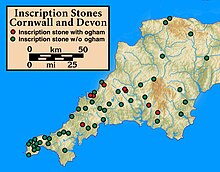Dumnonia
Dumnonia was a Celtic kingdom in post-Roman Britain . Its location was in the south west of what is now England and encompassed the area of what is now the county of Devon , as well as most of Somerset and possibly part of Dorset . Its eastern border cannot be determined with certainty. Constantine of Dumnonia, a king in the early 6th century, brought Cornwall under the control of his kingdom as a sub-kingdom. The empire existed from around the end of the 4th century until the early 9th century.
Name and language
The name of the kingdom is derived from the name of the Celtic tribe of the Dumnonians (Lat. Dumnonii ) who lived in this region even before the conquest of Britain by the Romans .
Dumnonia, with its variants Damnonia and Domnonia , is the Latin name for the territory. It was called the Kingdom of the West Welsh by the Saxons of neighboring Wessex . On Old Welsh as well as in the original language of the Britons it was known as Dyfneint . This form has survived in the name of the county of Devon, as well as in modern Welsh ( Dyfnaint ) and Cornish ( Dewans ).
The Dumnonians spoke a dialect of Celtic that may have been similar to Old Cornish. The presence of settlers from Ireland is confirmed by finds of stones marked with Ogham script.
history
During the Roman occupation of Britain , Dumnonia was under Roman administration as a civitas . The original capital will have been Exeter , known to the Romans as Isca Dumnoniorum and to the British as Caeresk . Isca Dumnoniorum was the capital of the Roman civitas of the Dumnonians. As the kingdom existed during the dark centuries , the few inscriptions on stone gain importance.
The actual kingdom of Dumnonia developed during the late 4th century parallel to the disappearance of the central Roman authority; With the departure of the Romans from Great Britain in 410 at the latest, Dumnonia became completely independent. It is not certain whether Dumnonia was a united kingdom or an amalgamation of several minor kingdoms. Cornwall appears to have had a considerable degree of independence in any event, as it may have been based on the territory of a sub-tribe, namely the Cornovii .
The decline of the kingdom began when a large part of the territory fell to the West Saxons between 652 and 685 . Cornwall as part of the former empire was able to maintain its independence until the 9th century.
The conflict with the Kingdom of Wessex had intensified as early as the beginning of the 7th century. By 658 at the latest, Dumnonia lost control of the Somerset area, which was north and east of the River Parrett , and in 710 it lost the rest of Somerset. No later than 20 years later, the rest of Devons had also been lost to the Kingdom of Wessex. This conflict, which lasted into the 9th century and ended with the rise of Dumnonia in Wessex, led to a continuous movement of refugees from the south-west of what is now England to Brittany , where the toponyms Domnonée and Cornouaille refer to this immigration. However, it is reported by Exter that the Celtic population lived on an equal footing with the Saxons who later immigrated into the 10th century . Only King Æthelstan of Wessex put an end to this situation . Part of Exeter kept the name Little Britain until the 18th century . It was also Æthelstan who established the western border of Wessex on the River Tamar , which reaffirmed the incorporation of Dumnonia into the Kingdom of Wessex.
Dumnonia is exceptional for its large number of Romano-British settlements . As in other British areas, Iron Age hill castles , such as Cadbury Castle , were restored and fortified in the course of the 5th century and served as rulers' seats. Others, however, such as Tintagel , were rebuilt. Imported post-Roman pottery was found during excavations in the region, an indication that Dumnonia had trade links with the rest of Europe.
Ruler of Dumnonia
Only a few rulers of Dumnonia are named in the sources and can be historically verified:
- Cynfawr - the name appears in an inscription on the so-called Drustanus stone in Fowey (Cornwall) as Cunomorus .
- Constantine of Dumnonia - is mentioned by Gildas as a tyrant in Dumnonia.
- Geraint - is mentioned in the Anglo-Saxon Chronicle in 710 as a king fighting against the West Saxons.
Individual evidence
- ↑ http://hefenfelth.wordpress.com/2009/01/31/lkm-dumnonia/
- ^ Leslie Alcock: Arthur's Britain. History and Archeology, AD 367-634 , p. 246
- ↑ Ken Dark: Britain and the End of the Roman Empire , p. 150
- ^ Peter Hunter Blair: Roman Britain and Early England, 55 BC-AD 871 , p. 210
- ^ FM Stenton: Anglo-Saxon England , p. 64
- ↑ DP Kirby: The Earliest English Kings , p. 160
- ^ FM Stenton: Anglo-Saxon England , p. 431
literature
- Leslie Alcock: Arthur's Britain. History and Archeology, AD 367-634 . Harmondsworth, London 1973, ISBN 0-14-021396-1 .
- Ken Dark: Britain and the End of the Roman Empire . Tempus, Stroud 2000, ISBN 0-7524-2532-3 .
- Ernest Frank Halliday: A History of Cornwall , 2nd edition. House of Stratus, Thirsk 2001, ISBN 0-7551-0817-5 .
- Peter Hunter Blair: Roman Britain and Early England, 55 BC-AD 871 . Thomas Nelson and Sons, Edinburgh 1963, ISBN 0-17-711044-9 .
- DP Kirby: The Earliest English Kings , Unwin Hyman, London 1991, ISBN 0-04-445691-3 .
- Christopher A. Snyder: The Britons (Peoples of Europe) . Blackwell, Oxford 2003, ISBN 0-631-22260-X .
- Frank Merry Stenton: Anglo-Saxon England , 3rd edition. Oxford University Press, Oxford 1971, ISBN 0-19-280139-2 .

